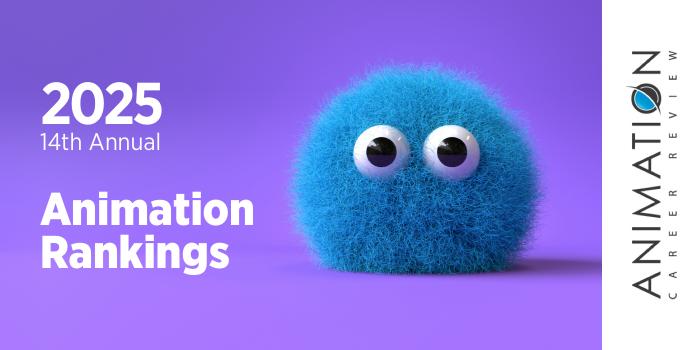
Master 3D modeling for film and video games in under 2 years with CG Spectrum. Get personalized career training online from leading 3D artists from major studios, plus career support and access to a vibrant community. Learn more.

| Ranking | School | State |
|---|---|---|
| 1 | Savannah College of Art and Design | Georgia |
| 2 | DePaul University | Illinois |
| 3 | Academy of Art University | California |
| 4 | Texas A&M University | Texas |
| 5 | University of Central Florida | Florida |
| 6 | University of Texas at Dallas | Texas |
| 7 | Purdue University | Indiana |
| 8 | Drexel University | Pennsylvania |
| 9 | University of Pennsylvania | Pennsylvania |
| 10 | North Carolina State University | North Carolina |
For our graduate degree rankings, we have evaluated animation schools and programs with the best Master of Arts (MA), Master of Fine Arts (MFA) and Master of Science (MS) options. To determine which degree matches your career goals, it is important to understand how each qualification differs.
The Master of Arts (MA) is an advanced degree that focuses on areas such as the humanities. MA degrees are typically available in the areas of communications, English, teaching, literature, linguistics, art, and languages. Seminars are the main method of learning for MA programs and most programs do not require a thesis.
The Master of Science (MS) degree option typically focuses on science, technology, engineering, and math. This advanced degree often includes immersive lab work, scientific research, analysis, and evaluation. Unlike MA programs, most MS programs require a thesis.
The Master of Fine Arts (MFA) is academically recognized as a terminal degree and it is typically awarded in the visual, fine and performing arts. The MFA degree demands the highest level of professional competency in these areas and practicing artists must exhibit the highest level of accomplishment through the generation of a body of work.

Savannah College of Art and Design (SCAD) operates the world’s largest university-run film festival. With attendance exceeding 63,000 annually, the eight-day Savannah Film Festival has welcomed Academy Award-winning guest speakers such as Mahershala Ali, Holly Hunter, and Jeremy Irons, along with directors such as Oliver Stone and Christopher Miller. All SCAD students may participate in the festival, which also features workshops, lectures, and networking opportunities.
SCAD students also have access to nearly one million square feet of dedicated film and television production space including Savannah Film Studios—one of the largest university film studios in the U.S.; the 65,000 square feet SCAD Digital Media Center; Lucas Theatre for the Arts; and the 82,000 square feet SCAD Museum of Art. Built on a historical site, the museum hosts exhibitions, screenings in an onsite theater, and master classes with industry professionals and visiting artists.
Savannah College of Art and Design is also home to the School of Animation and Motion. Serving approximately 1,985 students, the school’s Animation program has an MA pathway that features 24/7 access to more than 800 networked computers; instruction by artists from major studios and productions such as Ice Age, Pocahontas, and The Lion King; and the opportunity to participate in SCAD Study Abroad in Lacoste, France. In addition, students can complete the program at the Savannah campus and online through SCADnow.
Consisting of 45 credit hours of study, the SCAD Animation MA highlights courses such as 3D Naturalistic Character Animation; Computer-Generated Modeling and Design; Drawing in Motion; Animation Aesthetics and Practice; 3D Cartoon Character Animation; and Environment Look Development. Students also have the option to complete a graduate internship.
The culminating experience for the SCAD MA program is the School of Animation and Motion MA Final Project. During the experience, students propose, develop, and execute a project that will become a permanent part of their professional reel.
Graduates of the Animation MA program at Savannah College of Art and Design are prepared to pursue leadership roles and titles such as 2D Animator, 3D Animator, Digital Modeler, Storyboard Artist, Character FX Artist, Lighting Director, Animation Producer, and Character FX Technical Director.
Major studios and networks routinely hire SCAD Animation alumni. Examples include Cartoon Network, Electronic Arts (EA), Pixar, Sony Pictures Imageworks, 20th Century Fox, Epic Games, Walt Disney Animation Studios, DreamWorks, Nickelodeon, Lucasfilm Animation, and Xbox Game Studios.

The School of Cinematic Arts at DePaul University (DePaul) graduated its first class in 2005. Since then, the school has produced directors of hit television shows such as Grey’s Anatomy and The Blacklist; Emmy Award nominees such as Vera Drew; and animators for Guillermo del Toro's Pinocchio, Epic Games, and Gus Van Sant's Don't Worry, He Won't Get Far on Foot.
Housed in Jarvis College of Computing and Digital Media (CDM), the School of Cinematic Arts also provides many programs for students seeking careers in animation. For students seeking a Master of Arts, Jarvis has Animation MA, BA/MA, and BFA/MA programs.
Across all School of Cinematic Arts programs, students benefit from courses taught by award-winning filmmakers who are part of one of the nation’s largest full-time animation faculties; access to a state-of-the-art, 32,000 square feet production facility known as DePaul Cinespace Studios; and the new Jarvis Student Center for Innovation and Collaboration. This open, 8,000 square feet space focuses on industry partnerships and multidisciplinary professional learning across emerging technologies. Collaborations and projects between students and faculty emphasize innovation and community needs.
Cinespace and other CDM/SCA studios and facilities provide access to the latest industry-standard animation software, tools, and technologies. This includes Cintiq labs, stop motion stages, fabrication studios, 3D motion capture, motion control, sound studios, professional animation and effects software, and 3D printing.
All DePaul Animation students also have the unique opportunity to participate in the Los Angeles Quarter Program. Over 10 weeks, this immersive experience allows students to intern at major Hollywood studios such The Jim Henson Company, Disney, Warner Bros. Animation, DreamWorks Animation, Nickelodeon, Sony Studios, and Titmouse.
Additional program benefits include participation in the Premiere Film Festival; the Japan Study Abroad program; Project Bluelight; visiting artists from places such as Disney and Pixar; and access to the Animation Lodge.
The Premiere Film Festival displays and awards the best student work in animation and film. The event attracts jury members from around the country including filmmakers, industry insiders, and festival programmers.
The Japan Study Abroad program is a biennial trip that takes students to Nagoya, Kyoto, and Tokyo for tours of Japanese animation and game studios, cultural sites, and galleries.
Project Bluelight provides hands-on experience in motion picture production to all interested students. Students at The Lodge have opportunities to collaborate on group projects, build their portfolios, and network.
The Animation MA has five concentrations including Traditional Animation; Storyboarding and Character Design; 3D Animation; Technical Artist; and Motion Graphics. Course examples for the program include 3D Animation Production; Animation Figure Study; Advanced Topics in Visual Effects; Topics in 3D Animation; and Game Art Pipeline. The program culminates with a final project and presentation.
Graduates of the Animation programs at DePaul University are prepared to pursue leadership roles in industries such as film and television, games, and advertising. Program alumni have been hired at major studios and gaming companies such as Lucasfilm, DreamWorks Animation, Electronic Arts (EA), Warner Bros. Animation, Google, Cartoon Network, Disney Animation Studios, Epic Games, Nickelodeon, LAIKA, Blizzard Entertainment, Iron Galaxy Studios, and BioWare.

Academy of Art University (AAU) is one of the nation’s largest private, accredited art and design schools. With more than 70 alumni art shows and gallery exhibitions each year, AAU also has one of the most active alumni associations of all art and design schools.
For animators, Academy of Art University houses the Houdini Certified School of Animation and Visual Effects (VFX). All programs take place in a studio production environment known as StudioX. Founded more than 15 years ago, the AAU School of Animation and VFX is the only school of its kind to teach in this type of environment.
Because StudioX functions like most real-world studios, students gain hands-on experience using the same tools and techniques used in the industry. Students also benefit from individual and collaborative projects and Feature Animation Training (FAT) classes.
Taught by industry professionals from companies such as Industrial Light & Magic (ILM) and Pixar, FAT classes allow students to immerse in the mental processes of creating a character. Every Tuesday evening, students will also explore the emotional aspects of acting to enhance the characters they have created.
All degree-seeking FAT Tuesday students will complete an internship and create a professional portfolio of their best work. To date, StudioX students have been credited for their work on productions such as Beasts of the Southern Wild, I’m No Longer Here, Fruitvale Station, I Am A Man, Strawberry Mansion, and THEEB.
The School of Animation and VFX at Academy of Art houses an MA program that can be competed online or on campus. Four emphasis areas are available including 2D Animation and Stop Motion; VFX; 3D Animation; and 3D Modeling. Students in all areas will also focus in storytelling.
This 36-unit program consists of 33 units in the major and just three graduate liberal arts credits. Course examples include Traditional Animation 1-2; Cinematography for VFX; Advanced Character Animation; 3D Modeling and Animation (Maya); Organic Modeling 1-2; Real-Time Animation and Visual Effects; 3D Animation Studio; and Advanced Look Development and Lighting.
The Animation and VFX MA culminates with the production of a portfolio completed across two courses: Final Portfolio Preparation and Final Portfolio Preparation for Animators. In addition to developing a portfolio, students will gain communication, collaboration, networking, marketing, and workplace pipeline skills. Graduates are prepared to pursue leadership roles in the entertainment industry. Some program alumni have also gone on to teach.
Across all Academy of Art University programs, graduates have established careers at major companies and studios such as Marvel, Industrial Light & Magic (ILM), Pixar, Sony Pictures Imageworks, Paramount, Wieden + Kennedy, Sony Pictures Animation, LAIKA, Riot Games, Walt Disney Animation, Google, DNEG, and Weta Digital.

The College Station campus at Texas A&M University (TAMU) serves approximately 72,560 students, making it the largest campus by enrollment in the state and one of the largest public universities in the nation. One of the few American universities to have land-, sea- and space-grant designations, TAMU also houses one of the largest visual and performing arts colleges within a public university.
The College of Performance, Visualization and Fine Arts (PVFA) is a multidisciplinary school that provides programs in film, visualization, production, dance, theater, and music. Established nearly 35 years ago, the PVFA Visualization program provides an MS with eight emphasis areas including Computer Animation; Gaming; Augmented Reality (AR); Computer Graphics; Virtual Reality (VR); Interactive Design; User Experience Design; and Data Visualization.
This program has both thesis (32 credit hours) and non-thesis (36 credit hours) options. Non-thesis students will complete a portfolio and capstone project to graduate.
Free electives allow all MS students to develop additional (advanced) skills in their chosen focus area. Elective examples include Generative Art; 3D Modeling and Animation; Design Communication I-III; Advanced Animation; Rendering and Shading; Computer Animation; Time-Based Media; Digital Compositing; Physical Computing for Art and Design; Image Synthesis; and Computer Aided Sculpting.
All Visualization MS students have the opportunity to complete a professional internship worth eight credits. In addition, select Visualization graduate students may participate in a Summer Industry Workshop. Students in this intensive course will work with professionals from major animation studios to produce professional-grade short films. The course takes place all day, every day, for 10 weeks.
Across all TAMU Visualization programs, students benefit from access to state-of-the-art facilities and studios; courses taught by accomplished instructors; student organizations such as Texas Aggie Game Developers (TAGD), Women in Animation, and Viz Industry Fair (VIF); participation in the Annual Career Fair; and the Semester Away Program in Italy, Germany, and many other countries.
Graduates of the Visualization programs at Texas A&M University are prepared to pursue advanced roles in the entertainment industry, among others. Visualization graduates are routinely hired at major studios such as DreamWorks Animation, Pixar, Industrial Light & Magic (ILM), Walt Disney Animation Studios, and Reel FX Animation.

University of Central Florida (UCF) is home to Florida Interactive Entertainment Academy (FIEA). Developed in 2005 in partnership with State of Florida, the City of Orlando and UCF, the academy opened with just 12 students. Today, the academy enrolls more than 130 students annually in its Interactive Entertainment MS program.
Housed in the College of Sciences’ Nichols School of Communication and Media, the FIEA MS program provides access to state-of-the-art facilities such as Studio 500. Launched in 2008, the studio houses a 3,300 square feet motion capture stage, which is one of the largest on the east coast. The studio also houses a 3,500 square feet soundstage. These facilities sit on what is known as UCF Downtown—a 7,000 student campus that focuses on film, games, communication, and interactive media.
Other FIEA benefits include internships and the opportunity to work in production teams mentored by industry professionals. Mentors provide instruction in areas such as 3D animation and modeling, game design, technical art, motion capture, software engineering, and creative collaboration.
The FIEA Interactive Entertainment MS program requires 30 credit hours of study, including 12 credit hours of core courses; nine credit hours in a specialization, such as Art, Production or Programming; a practicum; and a capstone experience. The Capstone results in a large-scale project that will be presented at a special event for the FIEA community and invited guests.
Graduates of the Florida Interactive Entertainment Academy at University of Central Florida are prepared to pursue careers at major studios across the U.S. and abroad. To date, more than 250 companies have hired UCF FIEA graduates. Examples include Google, Electronic Arts (EA), Marvel, Sony, Gameloft, Microsoft Studios, Walt Disney Imagineering, Lockheed Martin, Epic Games, Industrial Light & Magic (ILM), Universal, Riot Games, Zynga, Ubisoft, Apple, DreamWorks, Blizzard Entertainment, Hasbro, Unity, Bungie, Gearbox Software, YouTube, Bethesda Softworks, and Naughty Dog.

University of Texas at Dallas (UT Dallas) is home to the state’s first arts and technology degree. Launched in 2002 and housed in the 50-year-old Harry W. Bass Jr. School of Arts, Humanities, and Technology (Bass School), the program is known as Arts, Technology, and Emerging Communication (ATEC). Today, the program has expanded to include BA, MA, MFA, and PhD degrees.
Across pathways, ATEC students benefit from interactions with guest speakers from major studios such as Pixar, DreamWorks, and Disney; seminars and lectures led by industry professionals; project-based exercises; and applied and experimental research in collaboration with instructors in varying areas of expertise.
For student productions, research, and other projects, the ATEC program provides access to Bass School research labs and creative practice studios such as ArtSciLab; LabSynthE; the Narrative Systems Research Lab; The Studio for Mediating Play; the Creative Automata Lab; Fashioning Circuits; the Cultural Science Lab; the 3D Studio; the Emerging Gizmology Lab; SP&CE Media; and the Public Interactives Research Lab (PIRL).
Students also have access to the ATEC Animation Lab. A major component of the lab is the simulated animated studio experience (SASE). Over two semesters, a crew of 40 SASE students will have the opportunity to design, write, produce, and direct a two-minute CG animated short film. Examples of past productions include Bad Timing (2022), Octo Ninja (2021), Night Shift (2020), and Stargazer (2019).
The ATEC MA curriculum provides advanced studies in computer-based arts, interactive media, and digital media. However, students may focus their studies in animation, science and technology, games, or other areas through free and other electives. Course and elective examples for the program include Virtual Worlds and Communities; Aesthetics of Interactive Arts; Emerging Media Studio; Interactive Narrative; Critical Game Studies; Digital Textuality; Play and Culture; Socially Conscious Games; and Creativity as Social Practice.
The ATEC MA at UT Dallas culminates with an advanced research project in digital media. These final projects will be presented to a master's committee for evaluation. Graduates are prepared to pursue careers in areas such as 3D computer animation, game design and development, virtual environments, medical and scientific visualization, advertising, modeling and simulation, architecture, publishing, law, education, and training.
Program alumni have been hired at companies and studios such as Disney, Blizzard Entertainment, 900lbs of Creative, Cisco Systems, JP Morgan Chase, Texas Instruments, AT&T Foundry, and Gearbox Software.

Purdue University (Purdue) houses 10 academic colleges that provide degrees at all levels across all disciplines. Among the school’s 10 colleges is Purdue Polytechnic Institute.
Formally organized in 1964 as the School of Technology and known as Purdue Polytechnic, the institute serves more than 7,000 students at 11 locations across Indiana. With six academic departments, the Polytechnic is the college for Purdue’s Division of Military Science and Technology and its three ROTC (Reserve Officers’ Training Corps) programs on campus.
One of the six departments of Purdue Polytechnic is the Department of Computer Graphics Technology (CGT). Within the department are two graduate programs for animators. Options include the CGT MS and a Five-Year CGT BS/MS. The CGT MS is part of Purdue’s Computational Interdisciplinary Graduate Program.
The CGT MS at Purdue Polytechnic Institute serves close to 100 students. Primary focus areas include Computer Animation; Information Visualization; Games; and UX Design. This highly flexible, interdisciplinary program provides opportunities to create a customized a plan of study or take coursework across other Purdue graduate programs. Thesis and non-thesis options are available.
The Computer Animation focus for the CGT MS covers the entire digital animation process. The program also explores visual effects, games, and virtual reality. Course examples include Animation History, Technology and Technique; Visual Intelligence and Perception; Current Topics in 3D Animation; Seminar in Computer Graphics Technology; The Art and Technology of Computer Animation; and The Development of Graphics in Technology. Elective requirements allow students to explore other areas of interest.
The culminating experience for the non-thesis CGT MS program at Purdue University is the Animation Capstone (Production). The non-thesis CGT MS culminates with the Animation Thesis Research project. Graduates of the Purdue Polytechnic Institute CGT MS program are prepared to pursue leadership roles across industries. Examples include Animation Director, Lead Technical Artist, Game Developer, Art Director, Senior Simulation and Visualization Specialist, Lead Animator, and Technical Director.
CGT MS program alumni have been hired at companies and studios such as Google, Salesforce, DreamWorks, and Deloitte. Some CGT MS graduates go on to apply for admission to Purdue Polytechnic’s Technology PhD program.

Drexel University has one of the largest cooperative education programs in the U.S. allowing students to gain up to 18 months of work experience in their chosen field—all before graduation. Drexel University also houses one of the nation’s largest media arts and design colleges.
The Antoinette Westphal College of Media Arts and Design provides eighteen undergraduate majors, twenty-six undergraduate minors, and several STEM-designated and accelerated degree programs across the entertainment, visual art, media, design, and performing arts. In addition to the co-op program, students in all programs benefit from a studio-based curriculum; courses led by industry professionals; and access to state-of-the-art production facilities and studios.
Examples include the Animation Capture and Effects Lab (ACE-Lab) consisting of 1,200 square feet of production space; computer labs outfitted with advanced graphics workstations; screening rooms; and the Immersive Research Lab for augmented reality, virtual reality, and immersive media projects.
The Antoinette Westphal College of Media Arts and Design at Drexel University (Drexel) provides several MS programs including the Digital Media MS; the Dual Animation and VFX BS/Digital Media MS; and the Digital Media and Virtual Production BS/Digital Media MS.
The Dual BS/MS programs consist of coursework and projects in animation, interactivity, gaming, 3D modeling, and digital design. The programs also explore digital media history, theory, and methods. Westphal dual BS/MS students can also participate in three co-op experiences in the second, third, and fourth years of study. Positions may be paid or unpaid.
Past co-op positions include animation, technical direction, visual effects (VFX), and 3D production work at places such as Cartoon Network, Pixar, 3FX Medical Animations, Sony Studios, Ingenuity Studios, and FuseFX.
The Digital Media MS at Drexel University is a STEM-designated, hybrid program that focuses on research and media applications. Areas explored include animation, gaming and digital media history, interactivity, advanced digital design, and 3D modeling. Course examples for the program include New Media: History, Theory and Methods; Designing for Interactivity; Animation and Game Design Bootcamp; Research Methods for Digital Media; and New Media Project.
Students in the MS program will complete several independent, industry-sponsored, student-created, or faculty-approved projects. Past projects have focused on areas such as animation design, advanced animation production techniques, video games, and narrative comics. This two-year program culminates with a thesis, oral presentation, and demonstration in the Department of Digital Media.
Graduates of the Animation/VFX and Digital Media programs at Drexel University are prepared to pursue advanced roles in the entertainment industry, game design and development, television production, advertising, and more. Program alumni have worked on projects such as The Mandalorian, How to Train Your Dragon 2, Ready Player One, and Avengers: Infinity War.
Graduates have also gone on to land positions in research and development in the fields of virtual reality, generative design, and real-time rendering solutions. Program alumni have been hired at places such as DreamWorks, Pixar, XBOX, Disney, NCSoft Corp, and Microsoft.

University of Pennsylvania (UPenn) is home to the Center for Human Modeling and Simulation (HMS). Established in 1975, the center is a leader in the fields of behavioral animation, 3D computer graphics, and human simulation. Within the center is a Computer Graphics and Game Technology (CGGT) Engineering MS (MSE) program that's ideal for students seeking an advanced degree in animation.
Established in 2004, the interdisciplinary CGGT MSE program covers four core areas including Creative Arts and Design; Computer Science, Systems and Technology; Product Design, Development and Production; and Business and Entrepreneurship. The Creative Arts and Design area explores 3D models and animation; storytelling and narrative; film studies; visual communication; human-computer interaction (HCI); and user interface (UI) design.
Other program highlights include access to equipment and resources available through the SIG Center for Computer Graphics; courses such as Computer Animation, Physically-Based Animation, and Advanced Project Animation; and the opportunity to specialize in areas such as Art and Animation, Animation and Simulation Technology, or Creative Design.
Graduates of the CGGT MS program are prepared to pursue advanced roles in the entertainment industry, games, architecture, advertising, and more. Across all UPenn creative and technical programs, alumni have been hired at places such as DreamWorks, Industrial Light & Magic (ILM), Microsoft, Pixar, Walt Disney Animation, Electronic Arts (EA), DreamWorks Animation, Zynga, Activision Blizzard, and Sony.

North Carolina State University (NC State) is home to the College of Design. Established in 1946 as the School of Architecture and Landscape Design, the College of Design provides dozens of degree and certificate programs in areas such as architecture, design, and media arts. Students in all areas will complete the College of Design’s interdisciplinary first-year experience along with workshops; swing studios in other majors; internships; and study abroad experiences in places such as Greece, Chile, and Prague.
Within the College of Design is the Department of Media Arts, Design and Technology (MADTech), which houses the Masters of Art + Design (MAD) program. This highly multidisciplinary program has three tracks. Track 1 consists of 30 credit hours); Track 2 requires 48 credit hours; and Track 3 consists of 72 credit hours.
Track 1 is designed for students with a strong background in experimental and interactive arts. Track 2 is designed for students with an undergraduate degree in interactive and experimental media. These students are likely seeking initial studios to explore new theories and concepts for their final projects.
Track 3 is ideal for students who do not have a strong background in interactive and experimental media arts. Though these students may have a degree in another area, they will need to spend the first year taking advanced undergraduate courses.
All options provide a variety of elective options to enhance the degree. Examples include 3D Animation; Digital Modeling; Creative Coding; Seminar in Animation; Sequential Imaging; Visualizing Narrative; Special Effects; Digital Motion; and Business of Design.
For all MAD tracks, the final year provides the opportunity to produce a project in animation, interactive media, or other area. Students who choose not to complete a project may produce a research-based study or paper.
Graduates of the MAD program at North Carolina State University are prepared to pursue leadership positions in fields such as animation, filmmaking, game design, digital special effects, multimedia, illustration, and software design. Some program alumni go on to launch their own studios or freelance businesses, while others become art and design educators and researchers at leading colleges and universities.